2016 saw Slovakia qualify for the finals of the UEFA European Championships for the first time since they were known as Czechoslovakia, and they surpassed the expectations of many by reaching the knockout phase that year, reaching the round of 16.
They made it back-to-back EURO qualifications by reaching the 2020 edition of the tournament but were unable to get past the group phase.
This year, in their third consecutive EURO appearance, they face another challenging task in getting out of the group stage, but how did they get here in the first place? Well, they finished second in their qualifying group, with Portugal taking the top spot.
Sokoli won an impressive seven out of 10 games in qualifying, scoring 17 and conceding just eight.
They’ll need to find a little bit of something extra in attack this summer if they are to make any real impact, and they’ll need a continuation of that strong defensive output.
This preview will provide a tactical analysis of Slovakia’s approach in possession, their tactics out of possession, and what to expect in transitions.
Furthermore, we will also discuss their predicted lineup and squad inclusions within this analysis.
Predicted Starting XI
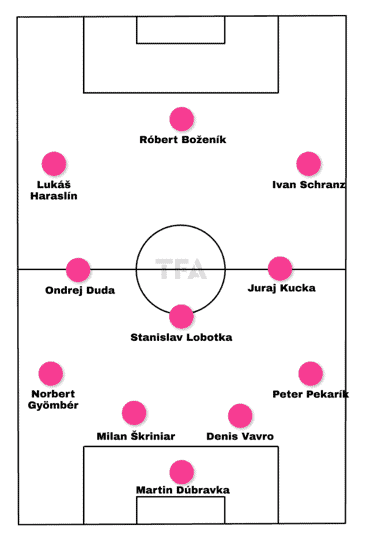
Slovakia manager Francesco Calzona, who has also been in charge of Serie A club Napoli since February on a short-term deal, has preferred the 4-3-3 shape for Sokoli more often than not, with the occasional use of a 4-1-4-1.
Gone are the days of relying on the playmaking genius Marek Hamšík, now retired and even had a stint in charge of the national team not too long ago.
Still, the experience remains the bedrock of this Slovakia lineup, with an expected five players aged 30+.
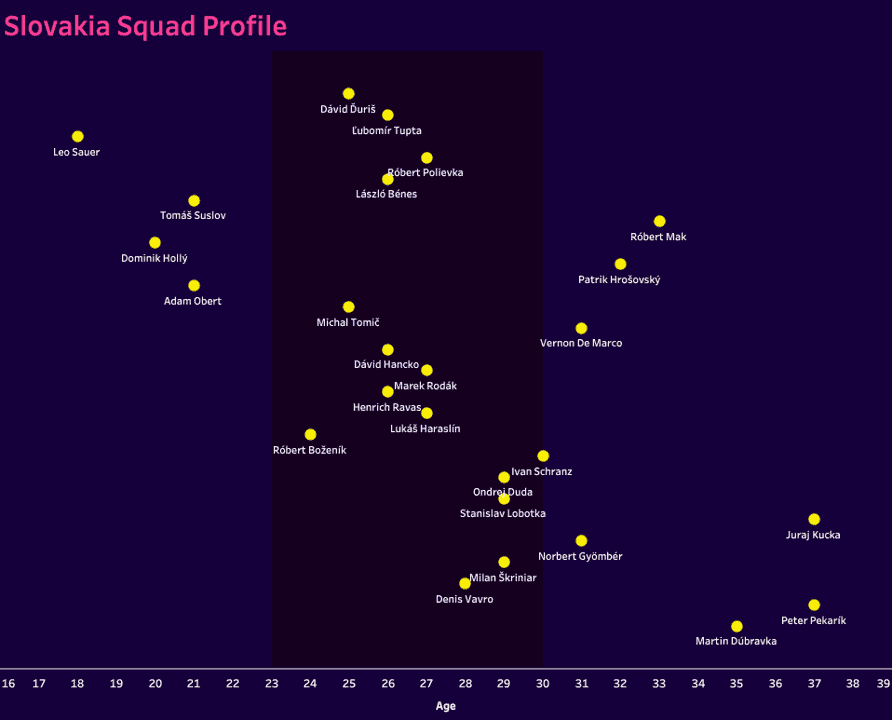
This graph emphasises the point regarding experience within the Slovakia squad, with numerous 30+ aged players, but balanced quite nicely with a selection of players in their prime years as a footballer.
With the official squad announcement yet to come from Slovakia (at the time of writing), there may be a few missing names from the graph above.
There is a small element of youth flowing through the potential Slovakia squad, based on previous games – 18-year-old forward Leo Sauer has been involved with the senior squad in recent fixtures and could be one of the youngest players to feature in the tournament this summer.
Meanwhile, the youngest likely regular starter in the group is 24-year-old forward Róbert Boženík, who has bagged nine goals in 30 games this season for Portuguese club Boavista.
Notable experienced names include Premier League goalkeeper Martin Dúbravka, Juraj Kucka, and Ondrej Duda – the latter two are likely to be regular features in the Slovakian midfield.
Attacking Phase
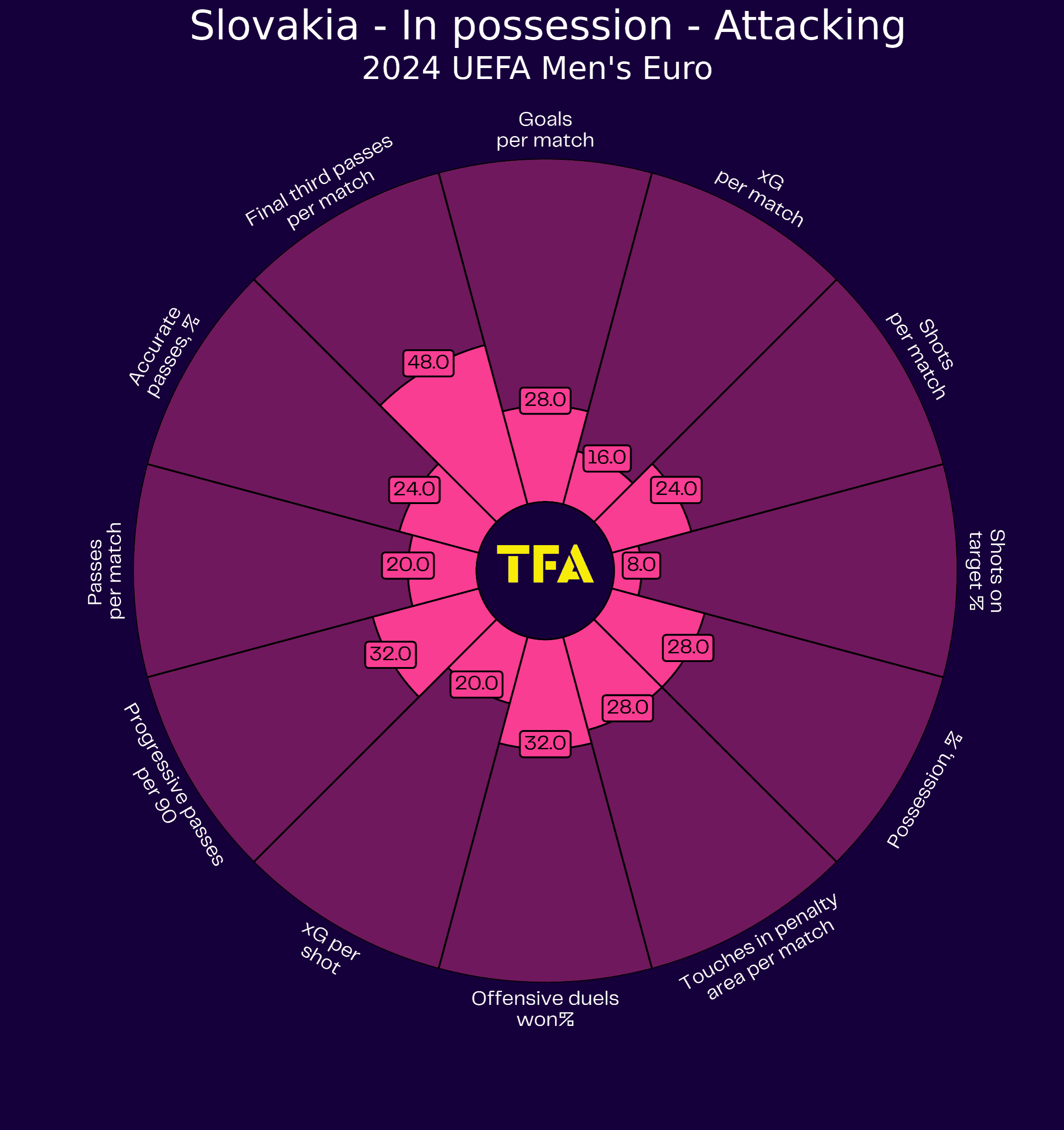
This graph suggests that we shouldn’t expect a flurry of attacking firepower from Slovakia this summer—a theme from their qualifying phase, too.
While their percentile rank for passes to the final third isn’t terrible, they’ll need to increase their output in that area if they want to damage opponents.
The same can be said for their shots per match and shot accuracy.
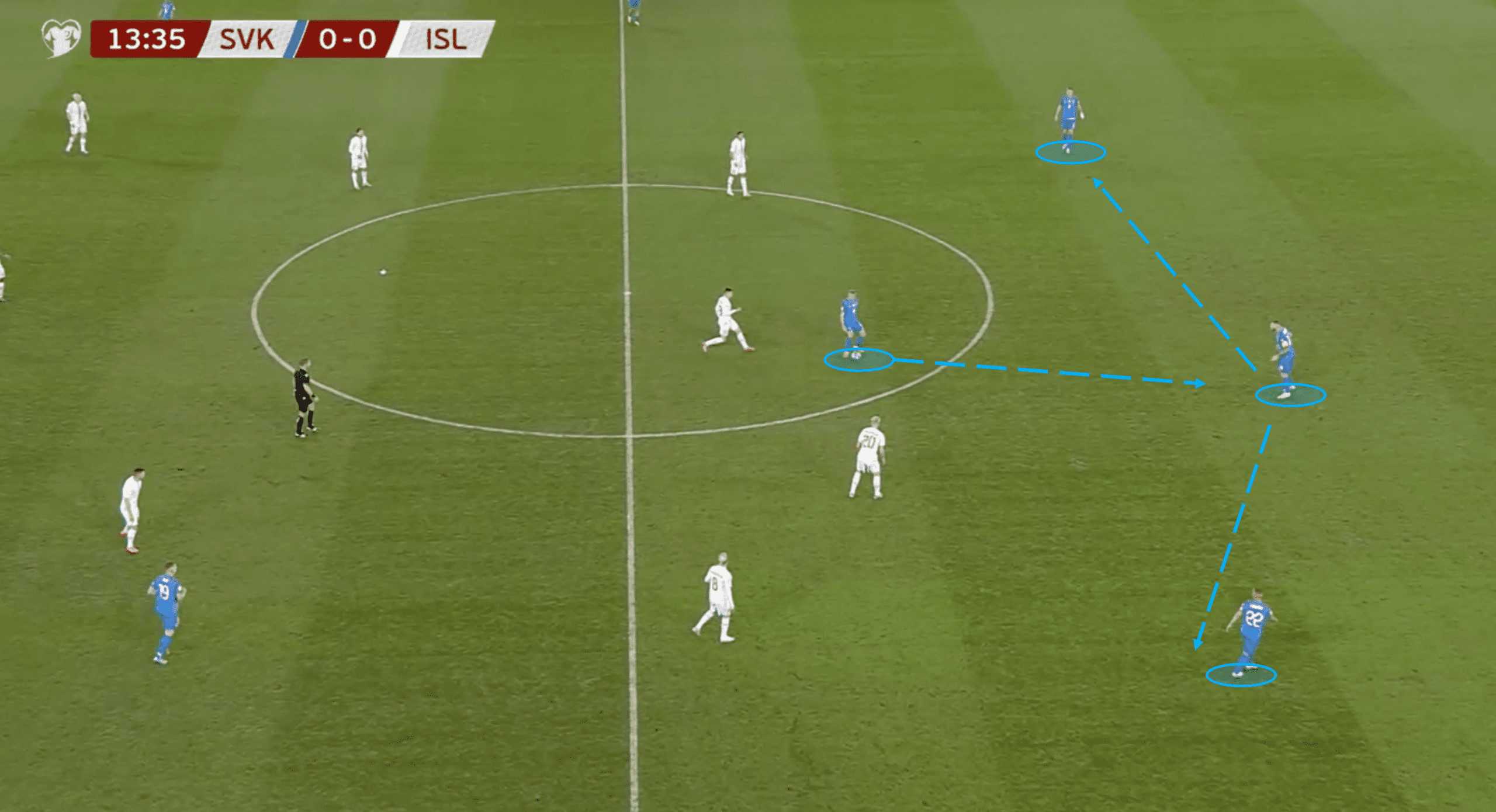
Slovakia aren’t a strictly possession-based team, and they’re also far from the typical route-one team some may expect them to be.
In the last calendar year, they’ve averaged 52.75% possession, indicating an ability to take control of certain games.
In those scenarios, they look to be patient in the opening moments of a phase, with one of the midfielders often dropping deep to form a makeshift back three, allowing the full-backs to push on.
Slovakia move the ball with patience, looking to draw the opponent out of position and create space further up – getting forward via the full-backs is something to look out for.
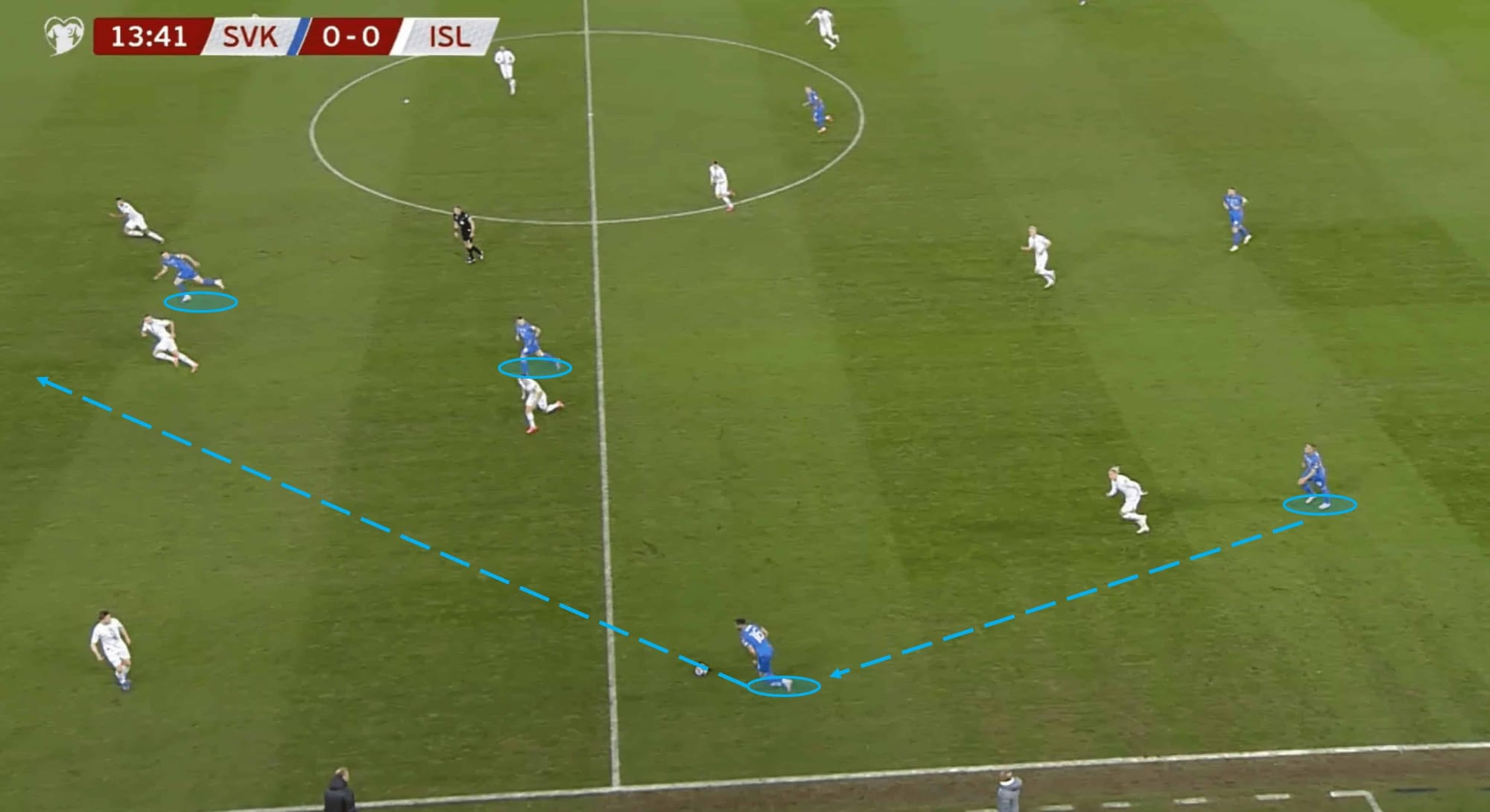
Having received the ball from the backline, the full-back often has time and space on his side to calculate his next move, and this is usually where we see an increase in tempo, having beaten the initial opposition press.
Their next move varies depending on the scenario.
While this example shows them looking to be more direct and get in behind the defence at the first opportunity, they do sometimes like to play through midfield, utilising combinations involving central midfielders, wingers, and sometimes full-backs.
Sometimes, the CF will drop in deeper to provide support for the build-up, where he will look to link with wide players.
This being said the above tactics are the ideal, the preferred way that Slovakia wants to play.
Of course, they don’t always have that luxury and are no strangers to being more direct—playing balls into channels or using line-breaking passes into the front line are good alternatives for them.
Either way, a common theme is a quick tempo in play once they enter the midfield third.
Defensive phase
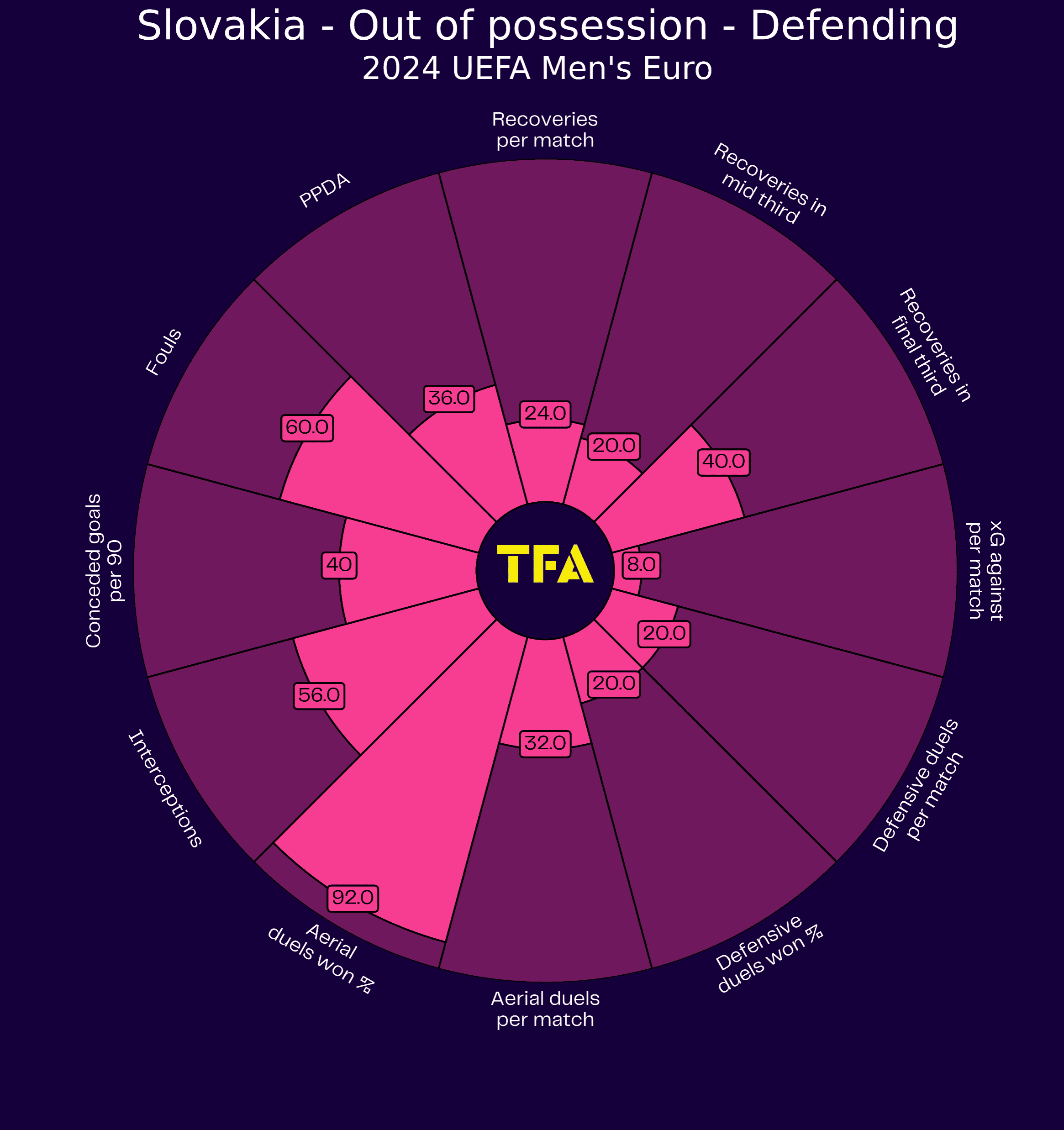
Slovakia brings a certain physical presence to the table, with aerial ability being one of their biggest strengths, as you can see in the graphic above.
However, they do post low percentiles in other key areas, such as winning defensive duels and xG against.
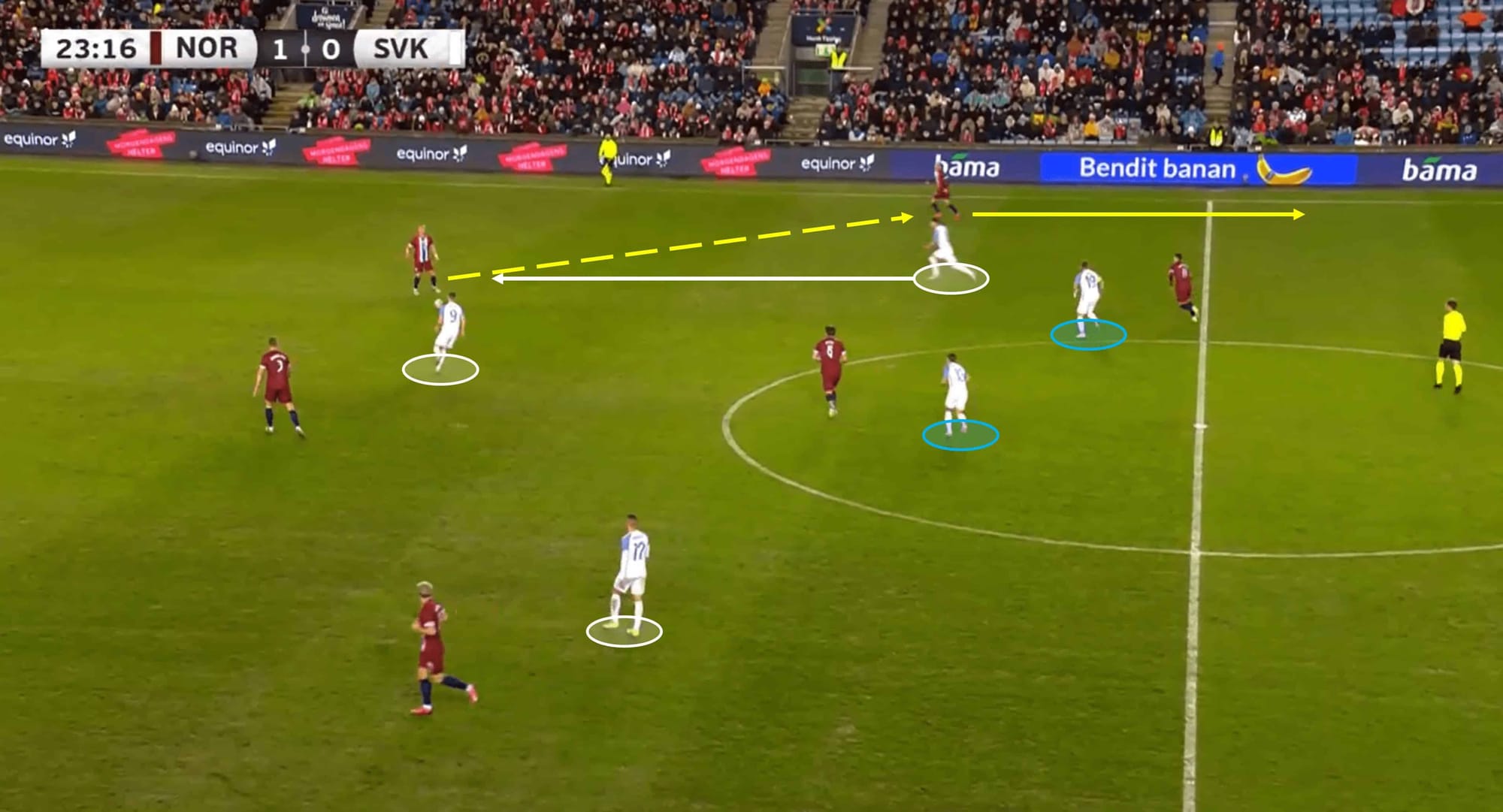
When it comes to Slovakia’s out-of-possession approach, in the last year, we’ve seen them press from the front with the wide players engaging the full-backs as the centre-forward presses the centre-backs.
Two of the midfielders will often push higher up to support the front three, with the deeper midfield remaining more defensive.
This, though, is where quality, or lack thereof, comes into play.
If Slovakia wants to cause an upset in qualifying for the knockout rounds, they’ll have to improve on their press timing and midfield structure.
Additionally, individual tactical understanding needs improvement.
In the image above, the right winger can be seen closing down the man on the ball despite being further away from it than his CF teammate.
This action jeopardises his defensive position.
Instead of marking/occupying the opposition’s left back, he leaves him free as the next passing option.
This could give the opponent a strong chance to break quickly down that left flank, something that higher–quality teams would be able to exploit.
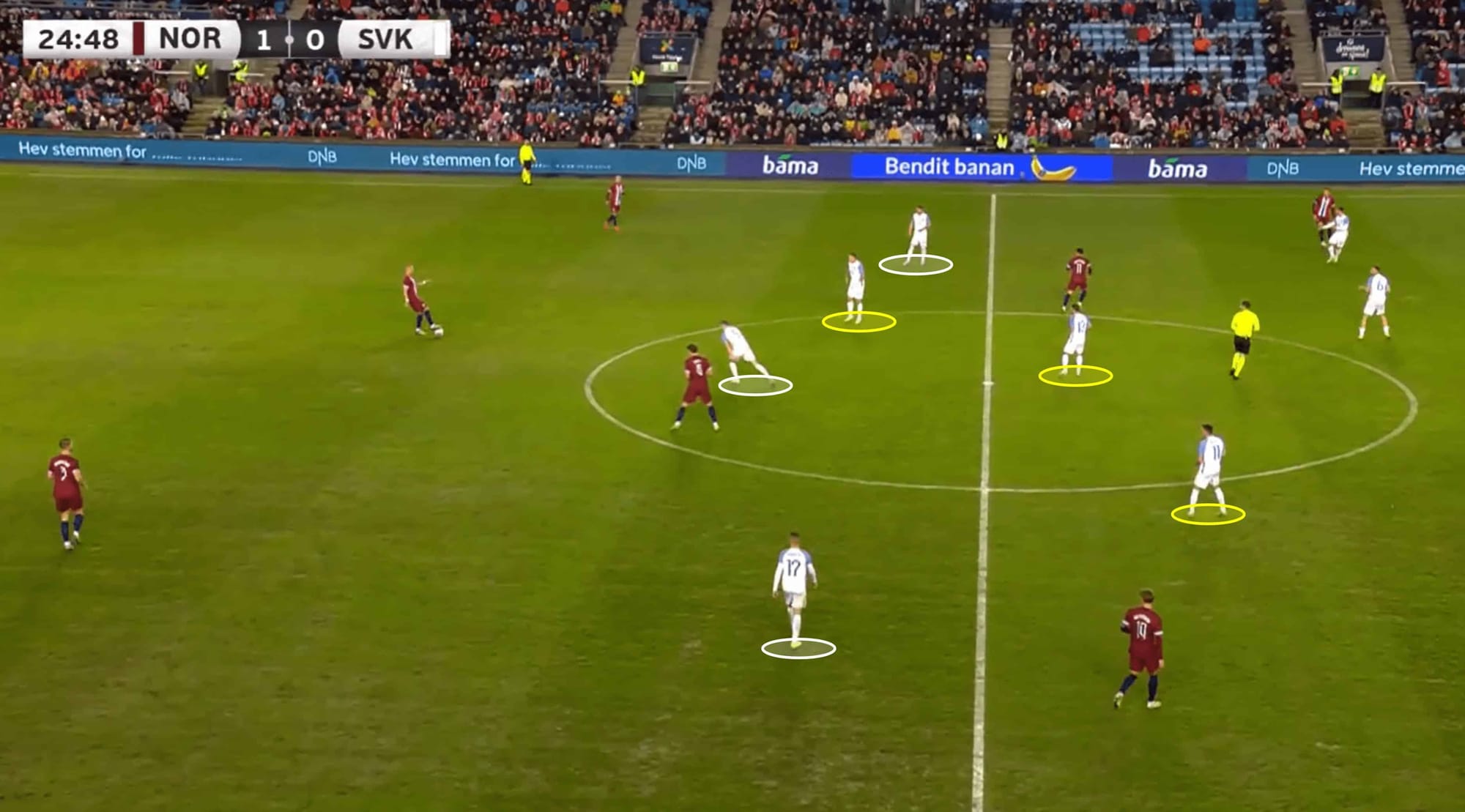
While Slovakia will look to press, as we’ve just seen, they use it with caution—expect them to apply more of a mid-block, especially against teams that aren’t top quality (France, England, etc.).
In those matches, they may sit deeper and look to soak up pressure to hit teams on the break.
But against teams that they feel more confident in, they’ll deploy a mid-block.
Transitions
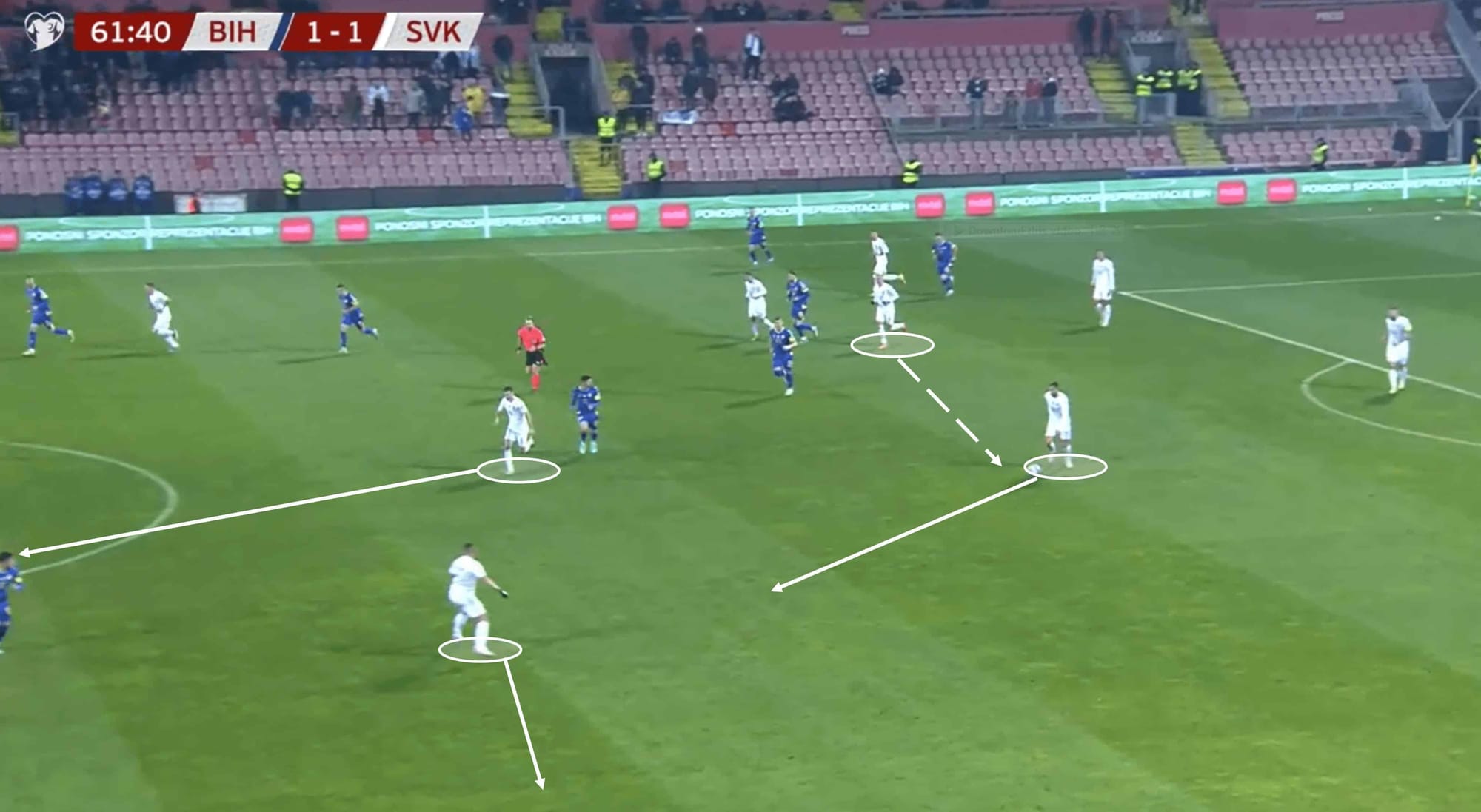
In attacking transitions, we see some reflecting elements from their general in possession tactics, in that they’re keen to move the ball forward quickly.
The first task after regaining the ball is to get the ball out to a teammate in space, which is matched by attacking & aggressive off-the-ball runs, as well as movements aimed at stretching the pitch to create space in higher areas.
Direct passes after the initial pass into space are not a rarity – the example above showcases the movements we mentioned, and the man on the ball travels forward a few yards before spraying a forward pass in behind the opposition defence.
When it comes to their reaction to losing the ball, they look to counterpress in central areas where possible – of course, this has to be executed well.
Otherwise, you run the risk of the opponents just catching you out and hitting you on the break.
In wide areas, they do run a similar risk in the sense that the full-backs are usually in higher positions in possession, meaning that those areas could be exploitable in transitions.
Forwards
As mentioned, Róbert Boženík will likely be the one to lead the Slovakian attack, but Róbert Polievka will be hot on his tail for that starting spot.
The 27-year-old forward has 22 G/A in 27 games this season in Slovakia’s top tier, so he is hoping to play a part this summer.
On the flanks, Ivan Schranz and Lukáš Haraslín are set to be the first choices this summer, but they have a couple of interesting options amongst the squad.
One of them is Leo Sauer, the 18-year-old winger Feyenoord winger who already has his first senior international cap.
Ľubomír Tupta and Dávid Ďuriš should also be among the squad this summer to provide more depth to the attacking ranks.
Whoever is tasked with leading the line this summer for Slovakia, Calzona will be looking for a good physical presence, with the front three aiming to play with attacking directness and aggression.
Midfielders
The midfield unit is a real blend of youth and experience, surpassing the expected lineup.
Youthful players such as Dominik Hollý (20, Jablonec) and Tomáš Suslov (21, Hellas Verona) will be hoping to get some good minutes this summer, as their ageing midfield will likely demand rotation.
At the same time, 33-year-old Róbert Mak could provide another layer of experience in the engine room if called upon.
Stanislav Lobotka is a vital member of the team and is likely to play the most minutes in that midfield unit.
The Napoli midfielder has excellent defensive qualities while also being technically sound, so his role in the team, both in and out of possession, can not be understated.
Another Serie A midfielder, Ondrej Duda, is also likely to play a crucial part in Slovakia’s attacking play alongside the vastly experienced Juraj Kucka, who has his fair share of Serie A experience, too – a common theme in this squad, it seems.
Defenders
Sticking with the Serie A theme, Milan Škriniar, who was a key player for Inter for a number of years before his move to PSG last year, is likely to play every minute this summer at the heart of the defence.
Denis Vavro, Peter Pekarík, and Norbert Gyömbér are likely to complete the back four, with a few younger alternatives set to complete the bench.
Michal Tomič (25, Slavia Prague), Adam Obert (21, Cagliari), and Dávid Hancko (26, Feyenoord) will likely be involved this summer, but there’s a chance that they act as backup to the predicted back four, although all three of those have started in select recent fixtures.
Vernon De Marco, another defender who has been involved in recent international fixtures, could be an important player at CB if Slovakia look to rotate things at the back.
At 31, he brings a wealth of experience – he currently has 66 caps for his nation, so he’s been in the setup for some time.
Key Player
While the likes of Škriniar, Dúbravka, and Duda are all set to play pivotal parts in Slovakia’s performance this tournament, one player, in particular, could be the difference maker – Stanislav Lobotka.
We already touched on his ability earlier in this analysis, but let’s take a closer look at his performance at club level this season.
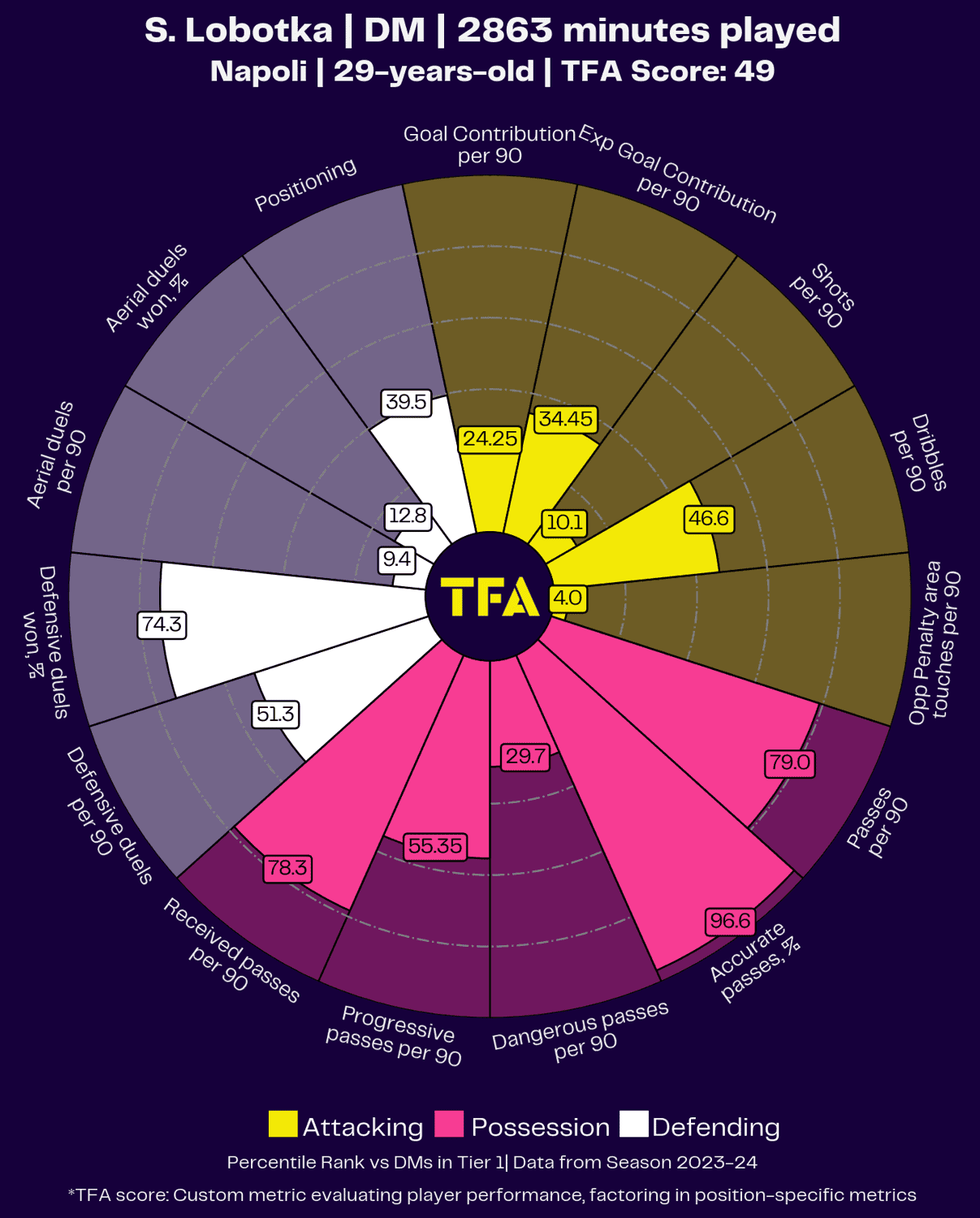
As the graph above shows, Lobotka brings a solid defensive presence in midfield but can also act as a deep-lying playmaker.
He covers less ground than his midfield teammates but plays an important role in a creative sense.
In particular, he plays a vital role in moving possession forward—his reliability on the ball will be key in Slovakia’s attacking tactics.
Don’t expect him to be a huge presence in the final third – the box-to-box role isn’t something we’re likely to see from the Napoli midfielder, but he is no stranger to carrying the ball from deep areas of midfield – again, a potentially important part of Slovakia’s tactics, particularly in transition.
Tournament prediction
There’s no sugarcoating this – Slovakia face one hell of a challenge in the group phase.
They share Group E with Belgium, Romania, and Ukraine.
You’d imagine Belgium is the favourite to win the group, with Ukraine likely holding the same title for that second-place spot.
Qualification to the knockout rounds is not entirely out of reach for Slovakia – they have a good manager at the helm an experienced squad with some high-calibre players.
Still, they’ll have to pick up points against Romania and Ukraine if they want to entertain the idea of making it to the knockouts.






Comments